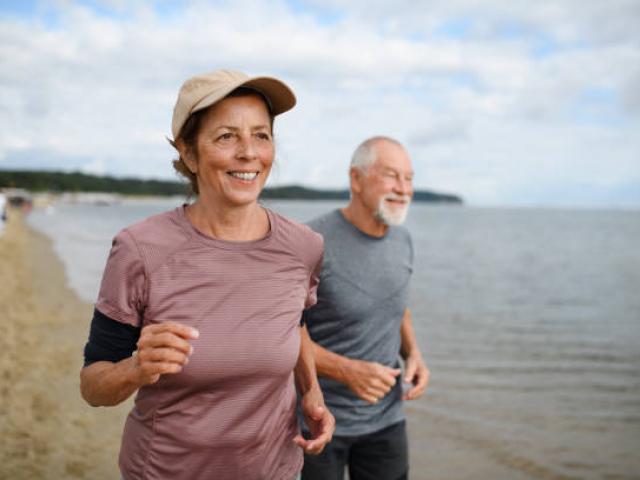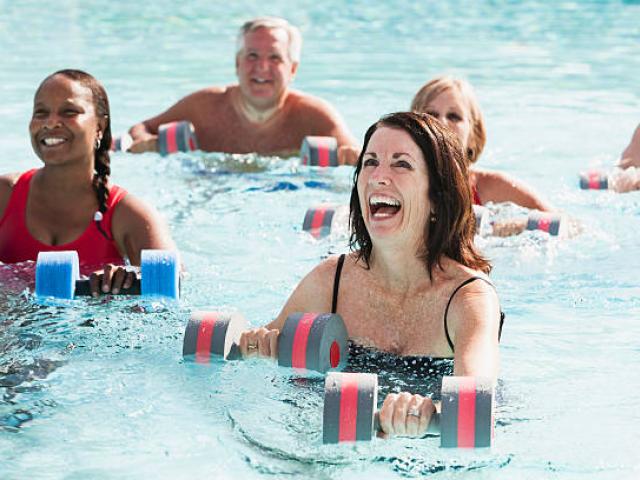Fitness for every age
The 30s
How we exercise will vary as we age. We’re living longer but still need to arrest the loss of muscle mass which begins in our 30s. Daily exercise may not be realistic as the demands of career and family begin. Branch out with workouts when you can, and try different exercise programmes such as high-intensity interval training: several minutes of high intensity anaerobic exercise to significantly increase your heart rate to at least 80% of its maximum, is followed by short periods of lower intensity movements. This type of cardio workout is challenging. It may be running, using a rowing machine, or sprinting up a flight of stairs. Some do it in bursts of between 30 seconds and three minutes. There is then a recovery period for roughly the same amount of time. This programme can save you time as you don’t have to exercise for as long.
The 40s and 50s

60 and over
The adage “use it or lose it” means it is never too late to start exercising. If your local pool offers aqua-aerobics, this can be a beneficial way of improving balance, building muscle strength and minimising impact on muscles and joints. Swimming is a valuable cardiovascular workout for any age. Studies have shown that even gentle pool lengths can improve memory and cognitive function, help repair brain cells and even aide the growth of new ones.

Complementary therapies - Reiki and Float Therapy
Reiki
Mary Hambly is a local Reiki teacher and practitioner. She is Vice-Chairperson of Reiki NZ Inc and editor of The Reiki News magazine. Mary is based at Mosgiel Holistic Centre, and also offers Reiki for horses and other animals through “Healing Horses”, her equine facility on Factory Road in Mosgiel. “Originating in Japan, Reiki can be translated as “Universal Life Force Energy”, says Mary. “A Reiki practitioner holds their hands over, or places them lightly on, the body of their fully-clothed client. During a treatment, the practitioner enters a relaxed state of compassion, in which they feel a deep connection with the client. A treatment may last from a few minutes to around an hour.
Whilst the full extent of the benefits of Reiki has yet to be completely understood by science, there is much anecdotal evidence of improvements in feelings of wellbeing and a sense of deep relaxation.” You can search for a Reiki practitioner or teacher at reiki.org.nz.
Float Therapy
Floating away…
The author of Winnie the Pooh, AA Milne, once said “How sweet to be a cloud. Floating in the blue!” I recently had the opportunity to experience Float Therapy for myself at the beautifully-appointed Well + Being centre in Dunedin. Float Therapy has existed since the 1950s when American neuropsychiatrist, John C. Lily, developed the first float tank. The benefits can vary and scientists in the USA are investigating how this therapy can positively help people who have depression, anxiety or PTSD (Post-Traumatic Stress Disorder). The essential mineral used, magnesium, plays a vital role in many bodily functions such as muscle and nerve function, blood sugar regulation, and heart health. Float Therapy can decrease body pain and aid muscle recovery. Floating is not advised for those with epilepsy, infectious diseases, open wounds, or if under the influence of drugs or alcohol. Fortunately, none of these applied to me and so on a freezing Dunedin day, I went along to try it.

Initially I felt as though I was getting into a very large bath. This was soon dispelled as I lay down and immediately bobbed to the surface in a zero-gravity sensation. It’s impossible to not float. With my head back, the ear plugs popped out. Unwelcome thoughts about my ears filling with salt intruded. Should I hold the ear plugs in? Do they really matter? As someone used to full immersion in a hot bath, it felt slightly strange to be floating on top of the water. Restlessly, I moved my arms to create little waves that took me from one side of the tank to the other. I rolled onto my front. I wondered how I was going to last for 45 minutes. And then, I just gave up (the ear plugs absence) and gave in (OK, this is different, but it’s bound to be doing me good), and I relaxed. Random thoughts came and went, floating away like the ear plugs. Apparently, many seasoned floaters fall asleep. I didn’t, but afterwards, scrubbing the salt from my hair and body, I felt incredibly serene and light-headed. That night, unusually for me, I slept soundly. If you want some time-out this winter and a way to leave the clatter of life behind, Float Therapy may just be the answer. –Gill Towle












